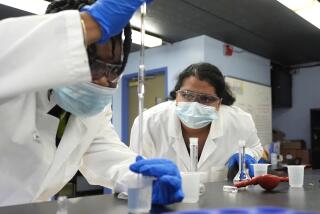Spate of Childhood Cancers Spurs a Mother’s Crusade
- Share via
ROCHESTER, N.Y. — At a typing class in high school three years ago, Chris Cusenz noticed he had lost all feeling in two fingers of his right hand.
An imaging scan detected a tumor inside the teenager’s spinal cord. Extending down from his brain stem, it was already 15 inches long.
Three surgeries, a spell in a psychiatric ward, a clunky brace to protect his weakened spine when he plays basketball: The journey has left Cusenz partially paralyzed and deeply embittered at age 21, with a life expectancy of one to four years.
Like any mother whose child is stricken with a rare illness--just 150 people worldwide are diagnosed each year with cancer that originates in the spinal cord--Debbie Cusenz wonders whether she was somehow to blame.
“Was it something I used in the home? Was it possibly places we took him? Did I not push the issue that he was quite small for his age and quite slow mentally?” she asks, her eyes filling with tears.
“Everyone tells me I can drive myself insane asking these questions. I truly feel I’m a good mother, but I still ask them.”
The cause of at least 90% of central nervous system tumors--the second most common childhood cancer after leukemia--is a mystery. Chris falls within that conundrum, and his mother is unlikely to find any answers.
But, in her mind, this manufacturing hub where the family moved when Chris was an infant may be to blame. After a two-year crusade, she persuaded federal health investigators to take a closer look at childhood cancers here.
The Atlanta-based Agency for Toxic Substances and Disease Registry, which has explored the relationship between illness and exposure to environmental contaminants since 1980, is expected to decide soon whether to conduct an epidemiological study.
To the local health director, Dr. Andrew Doniger, Debbie Cusenz’s “very forceful and persuasive” plea is missing one key ingredient--evidence of unusually high cancer rates.
Although the number of children afflicted with central nervous system cancer has more than doubled in Rochester in the 1990s, “the truth is, we don’t have a problem here,” Doniger said.
After an 18-month review, he concluded in the spring that “there was no cluster or common factor. But we have been unable to communicate this adequately to families. There is a tremendous amount of fear.
“They’re struggling with issues we all struggle with in trying to understand how the environment relates to the causes of disease. It is very human to me, very spirited and emotional.”
And Eastman Kodak Co., New York’s major polluter, says occupational health studies have never shown that its large plant for making photographic film could be even remotely to blame. Lawyers for the parents of seven stricken children say they intend to file suit against Kodak nonetheless.
Debbie Cusenz, 40, whose husband has worked for Kodak for 19 years, will not be among the litigants. She believes the cause is much more complicated, perhaps triggered by a combination of genetic, environmental and other factors, and attorneys are the last people she’d turn to.
“I’m not pointing the finger at one particular company--I’m looking at all possible sources, including hazardous waste sites, the water, pesticides,” she said. “There’s not a research scientist or an epidemiologist who can prove it’s one particular thing.
“But what really bothers me,” she adds, “is public health officials say it’s not a problem. To me, any child with cancer is a problem.”
Thousands of community cancer clusters have been investigated around the United States, 250 of them in New York alone since 1981. Not one has been traced to an environmental cause.
Because most community clusters seem to occur by chance, health officials are often reluctant to look deeper. The federal Centers for Disease Control and Prevention gave up routinely assessing them in 1990, frustrated that expensive studies yielded scant results.
Debbie Cusenz drew CDC’s sister agency to town by way of a letter from her congressman--an unusual approach that highlights the growing sensitivity of federal regulators and scientists to community concerns.
Although brain cancer rates have been climbing for 30 years, “there’s almost no data on what causes brain cancer, environmental or otherwise,” said Dr. Wendy Kaye, chief of the toxic substance agency’s epidemiology branch.
A study here is unlikely to pinpoint any causes but might be a valuable jigsaw piece. “What you’re looking for almost is hypotheses that then can be tested in multiple other places,” Kaye said.
The first disturbing sign came into Debbie Cusenz’s view as she prepared for her eldest son’s second surgery in New York City in November 1995.
At the Ronald McDonald House, where out-of-town parents can stay while their children are being treated at city hospitals, she struck up a conversation with another mother.
They discovered that both their children had exactly the same cancer, had the same doctor and lived a mile apart in Greece, a Rochester suburb with a skyline dominated by the smokestacks of 2,200-acre Kodak Park.
Encountering dozens of such families on their trail through hospitals made them and others suspect increasingly that contracting certain cancers might have something to do with their environment.
Many young cancer victims, they say, live in neighborhoods within a mile or two of a heavily industrial section anchored by Kodak Park, which spews out 7.6 million pounds of pollutants every year.
Kodak’s annual discharge of methylene chloride, a probable carcinogen, has tumbled 73% in a decade to 2.4 million pounds; fence-line air concentrations of the solvent register below state guidelines of 17 parts per billion.
In Rochester and surrounding Monroe County, home to 700,000 people, 20 children under age 15 contracted central nervous system cancers between 1985 and 1989. Over the next five years, the number jumped to 45.
The countywide cancer rate appears less striking. From 1983 to 1987, there were 1.66 cases per 100,000 people--low compared with the Upstate New York average of 2.85 cases.
From 1989 to 1993, the rate accelerated to 4.25. Although higher than the Upstate New York and nationwide average of around 3.4, it still lies within statistical variation rates.
“There might actually be something going on but it’s not large enough to be statistically detectable,” said Aura Weinstein, New York state Health Department’s director of cancer surveillance.
While genetic, occupational and medicinal factors “tell us almost everything we know about the cause of cancer in the human,” clusters in a community are nearly always fruitless, said Dr. Robert Miller, an epidemiologist with the National Cancer Institute.
Because the Rochester cancers have not been linked to a specific suspicious agent, “this would not be a good bet,” he said. “It would take up your time and your money and probably not give you a new understanding.”






